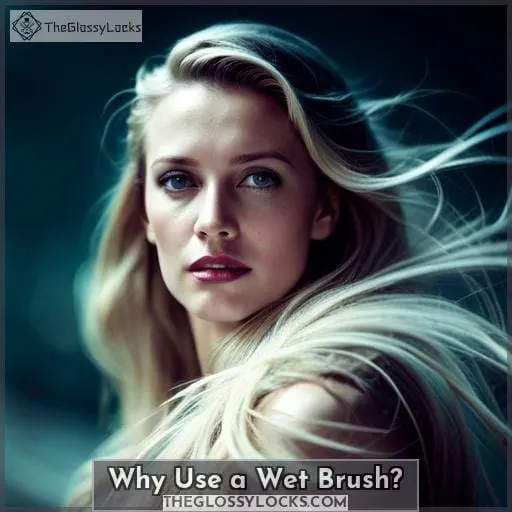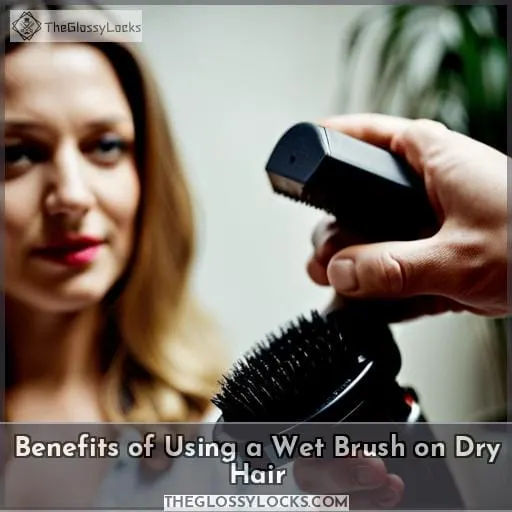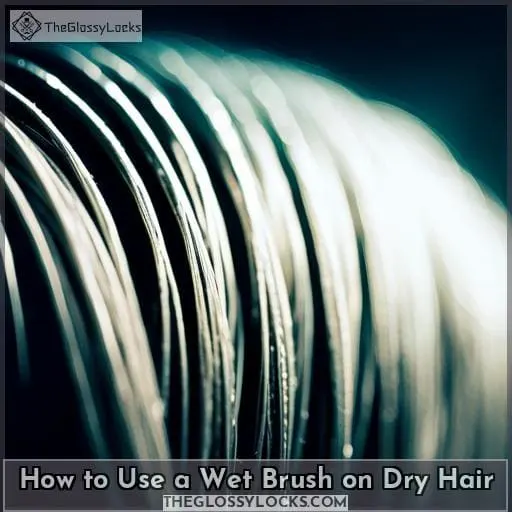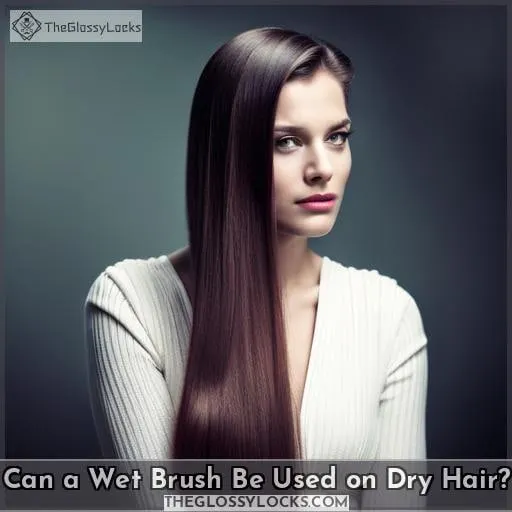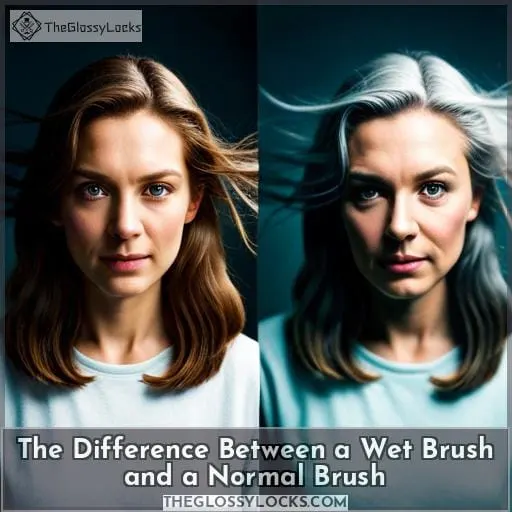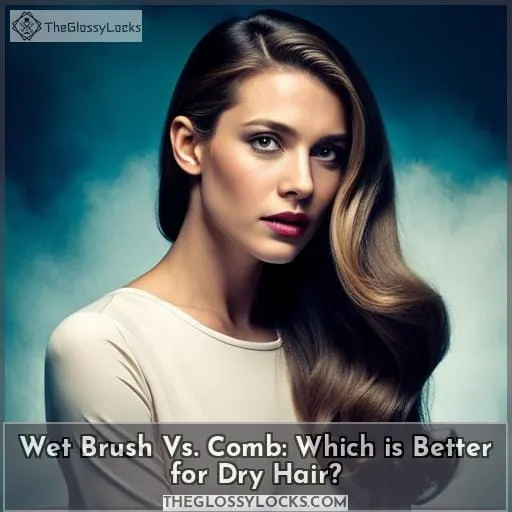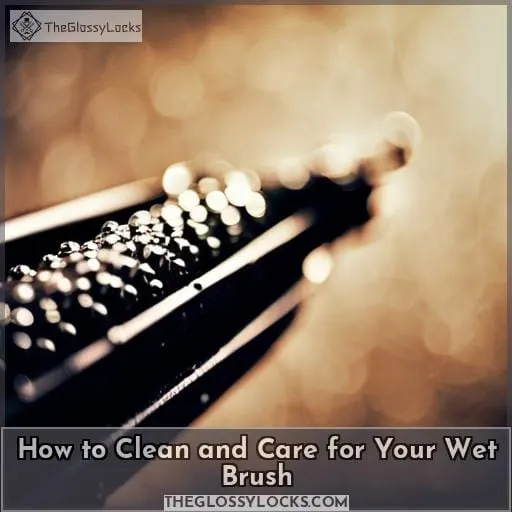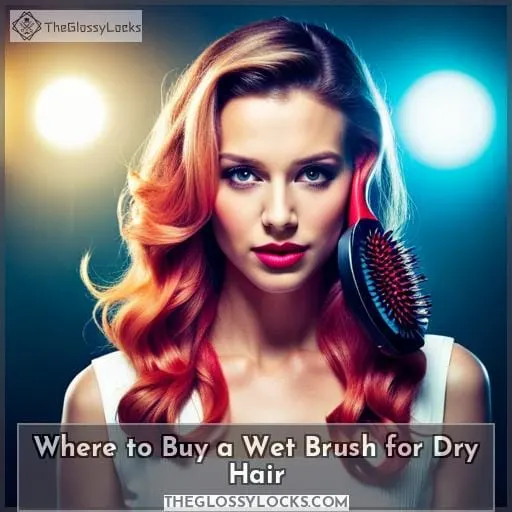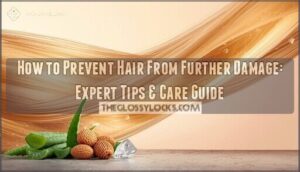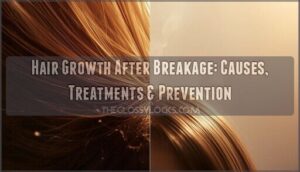This site is supported by our readers. We may earn a commission, at no cost to you, if you purchase through links.
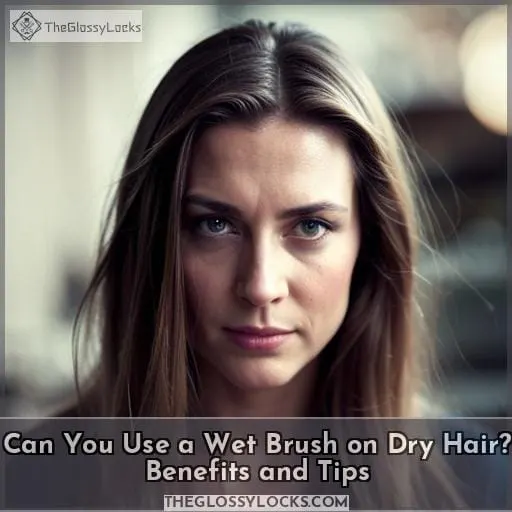
So, can you use a wet brush on dry hair? Read below to find out the benefits and tips associated with using a wet brush, as well as how it differs from other common brushes and combs available today.
Table Of Contents
- Key Takeaways
- Why Use a Wet Brush?
- Benefits of Using a Wet Brush on Dry Hair
- How to Use a Wet Brush on Dry Hair
- Can a Wet Brush Be Used on Dry Hair?
- The Difference Between a Wet Brush and a Normal Brush
- Wet Brush Vs. Comb: Which is Better for Dry Hair?
- How to Clean and Care for Your Wet Brush
- Where to Buy a Wet Brush for Dry Hair
- Conclusion
Key Takeaways
- Wet brushes can be used effectively on both wet and dry hair.
- Using a wet brush on dry hair can minimize hair damage and reduce breakage by 45% compared to other brushes.
- Wet brushes distribute natural oils, promote scalp health, and prevent product buildup.
- Wet brushes can be used for styling and daily hair care, providing comfort and hair health benefits.
Why Use a Wet Brush?
Using a Wet Brush helps keep your hair healthy, vibrant, and damage-free while providing an effortless detangling experience. Wet brushes are designed with flexible bristles that move with the hair’s natural shape to prevent breakage or pulling out strands.
They are also gentle on knots and tangles, making brushing easy without causing pain or discomfort.
The wet brush is ideal for those who want to take extra care of their scalp as it stimulates follicles, reduces dry scalps, and prevents product buildup, which can lead to dandruff problems in the future.
In addition, the wet brush distributes natural oils from your scalp down through all parts of your locks, allowing them to maintain their healthiness at all times. This will result in shinier hair when styling. Furthermore, using a Wet Brush prevents further damage such as split ends because it glides through each strand effortlessly, unlike traditional brushes that often tug harshly.
With regular use, you’ll notice fewer tangles after showering due to its unique design, ensuring that not one single knot goes unnoticed during grooming sessions. The best part about these innovative tools is that they come at affordable prices, typically under $15.
So you don’t have to worry about breaking the bank to incorporate good quality products into your routine.
Why not give yourself some much-needed TLC today by investing in one of these genius inventions now? Your once limp and lifeless tresses won’t know what hit them after only a few uses.
Benefits of Using a Wet Brush on Dry Hair
Using a Wet Brush on your dry hair can be an effective way to minimize damage, promote scalp health, and gently detangle all hair types. Its flexible bristles move with the strands of your hair, reducing pulling and tugging that cause breakage.
Minimizes hair damage
Gently brushing your hair with a wet brush helps minimize damage, ensuring long-lasting luster and shine. Wet brushes are designed to be extra gentle on the cuticle layer of the hair compared to other styling tools.
This protects against split ends and breakage associated with using regular combs or brushes on dry strands.
The flexible bristles move more easily over tangled sections, detangling without pulling or tugging too harshly.
Promotes scalp health
Brushing your hair with a Wet Brush can help keep your scalp healthy and invigorated. It stimulates blood circulation to the roots of the hair, promoting better nutrition for healthier follicles. The soft, flexible bristles are compatible with all types of hair, from thick curly to fine straight.
The brush also assists in removing product buildup and provides styling tips to reduce damage from excessive heat or brushing too hard.
Using a Wet Brush on dry hair allows for an effective scalp massage, essential for overall health and well-being.
Key benefits of using a Wet Brush include:
- Stimulates blood circulation
- Compatible with all types of hair
- Removes product buildup
- Provides styling tips
- Allows effective scalp massage
Suitable for all hair types
No matter your hair type, a Wet Brush can help maintain the health of your scalp – with 45% less breakage than other brushes!
Dry Hair Benefits:
- A Wet Brush is suitable for all hair types, including thick, curly, and coarse hair.
- Its ergonomic design makes it perfect for styling and daily care.
- The ultra-soft bristles reduce pain while protecting against split ends.
- It helps to remove product build-up from the scalp and improves circulation through gentle scrubbing.
- Plus, it’s affordable at under $15!
Scalp Health:
- A Wet Brush is an easy choice when looking to protect your hair.
- Its flexibility allows it to move along with each strand without causing further damage or breakage.
- This is essential in a dry haircare routine.
Hair Types Compatibility:
- The Wet Brush is suitable for all hair types, including thick, curly, and coarse hair.
Styling Tips:
- Use the Wet Brush for styling and daily hair care.
Maintenance Tips:
- To maintain the health of your scalp, use the Wet Brush to gently scrub and remove product build-up.
- This will also improve circulation.
How to Use a Wet Brush on Dry Hair
Effortlessly glide your Wet Brush through dry hair to detangle and add shine. With the right technique, you can use a wet brush on dry hair without causing any damage.
- Start at the ends of your hair and slowly work up towards the scalp, brushing small sections at a time. This will prevent breakage by avoiding tangles or knots in one spot for too long.
- Use gentle strokes while brushing. Going too hard or pulling may cause damage to delicate strands. It’s important not to rush this process as taking your time ensures that each section is properly detangled with minimal tension put on fragile hairs near the root area where they are most vulnerable.
- Consider using products specifically made for protecting dry tresses like leave-in conditioners or nourishing oils applied before combing out locks.
Can a Wet Brush Be Used on Dry Hair?
You can effortlessly style your locks with a wet brush, even on dry hair. Wet brushes are designed to be gentle and effective detangling tools for both wet and dry hair without causing damage. They feature soft bristles that flex with the hair, meaning they’re less likely to pull or snag individual strands than other types of brushes.
This makes them ideal for use on all types of manes, including fine or damaged ones, as well as thick curly styles.
Using a wet brush before showering can help protect against tangles. Brushing after washing helps distribute natural scalp oils evenly across the head, which promotes healthy growth and shine. The right type of product will depend on your specific needs. If you have long delicate tresses, opt for one such as the Wet Brush Shower Hook.
Thicker, more coarse varieties may benefit from something like the Wet Brush Flex Quicker Dryer Hairbrush instead. Those looking to enhance their shine should go for something like the Shine combination boar/flexible bristle option by this same brand name.
No matter what kind you choose, it’s highly recommended that these items get cleaned regularly using shampoo, then rinsed off thoroughly in warm water afterwards.
Aside from regular maintenance, diet supplements taken internally provide additional nourishment necessary to keep your scalp clean, hydrated, strong, and healthy, thus preventing future breakage caused by over-brushing, etc.
The Difference Between a Wet Brush and a Normal Brush
Comparing a Wet Brush to its traditional counterpart, you’ll quickly spot the difference in terms of bristles and design. While both brushes are designed for detangling hair, wet brushes feature flexible bristles that move with your hair strands instead of breaking them off like a normal brush does.
With its ergonomic handle and ultra-soft bristles, a wet brush is gentle on all types of dry or damp hair without causing damage or breakage. When selecting the right type of brush for your needs, it’s important to consider how often you plan on brushing as well as what type of hairstyle you want to achieve afterward.
To get maximum benefits from using a Wet Brush, such as reduced scalp dryness and fewer tangles while minimizing shedding, use it regularly every day before showering or styling your locks! Start at the bottom and work up towards the roots using light strokes with minimal pressure, so that no additional strain is put onto delicate tresses.
Additionally, make sure not to select any metal rails based on which could potentially cause more harm than good when used on already damaged hairs! Finally, if used correctly, these specialized tools can help improve overall healthiness while promoting luscious shine through distributing natural oils evenly throughout each strand!
Wet Brush Vs. Comb: Which is Better for Dry Hair?
When it comes to dry hair, a wet brush and comb are both great tools for detangling. But which one is the right fit for you? Both options provide benefits that help maintain scalp health and improve your overall hair care routine.
- Gentle Detangling – The flexible bristles of a wet brush can easily glide through tangles without tugging or causing damage, while a comb may cause breakage on delicate strands if used improperly.
- Product Buildup – Wet brushes have been designed to remove product buildup from styling products such as gels and sprays effectively, whereas combs struggle with this task because of their smaller teeth structure.
- Hair Types – A variety of different wet brushes exist suited specifically for different types of hair including thick, curly or coarse concerns; something that cannot be provided by combs alone.
- Comfortability – Wet brushes usually come with an ergonomic design making them easier to use than regular combs due to their rubber handle feature, which offers more grip when brushing out knots in thicker textured hairs.
No matter what type of tool you choose, make sure it suits your individual needs so you can get the most benefit from each session! With plenty of affordable brands available at major retailers like Original Wet Brush, Shine Brush, and Shower Flex Brushes, finding the perfect match has never been simpler!
How to Clean and Care for Your Wet Brush
Optimizing your hair health requires more than just external care. To keep your mane looking and feeling its best, it is important to promote healthy hair from within as well as take special precautions when cleaning and caring for wet brushes.
Using a scalp scrub can help you achieve optimal results by removing buildup while stimulating circulation of the scalp.
Promoting Healthy Hair From Within
For healthier hair, consider adding diet supplements to your daily routine for inner nourishment. Hair supplements provide nutritional support and can help maintain scalp health, promoting strong, healthy hair growth.
A balanced diet is essential in maintaining overall health, but you may find that it’s not enough to have the optimum levels of nutrients needed for beautiful locks.
To keep your tresses looking their best from within, try incorporating natural oils into your haircare routine. Additionally, taking regular breaks from styling products such as heat tools or chemical treatments, which can damage delicate strands over time, is important.
Taking care of both the inside and outside of your mane will ensure maximum potential for long-lasting results, so don’t forget about investing in inner care too!
Using a Scalp Scrub for Optimal Results
Regularly exfoliating your scalp with a scrub can help boost hair health and promote better circulation. A scalp scrub is an effective way to remove dead skin cells, product buildup, and dirt or oil from the surface of your head.
It also helps to massage away tension in the area, which can lead to improved blood flow.
Scalp scrubs are often used as part of dry haircare routines for people with thinning hair or damaged strands, but they work just as well on healthy locks too! When using a wet brush on dry hair, you’ll want to make sure it has flexible bristles so that it won’t cause any damage while detangling knots or styling strands.
After massaging the scrub into your scalp, thoroughly rinse off all residue before continuing onto other haircare steps, such as conditioning treatments and styling products, for optimal results.
Where to Buy a Wet Brush for Dry Hair
To keep your hair looking healthy, consider buying a Wet Brush specifically designed for dry hair. There are many different brands and retailers offering wet brushes with varying prices to suit all budgets.
Popular online stores such as Amazon have a wide selection of best-selling wet brush products available for purchase, while major retail stores like Walmart also carry their own brands at more affordable prices.
Whether you’re looking for an original design or the latest model featuring advanced features, there are plenty of options out there that can help make detangling dry hair easier and less damaging to its structure than traditional brushing methods.
When choosing a Wet Brush suitable for use on dry hair, it is important to look at what type of bristles the product has. Some may be too stiff and harsh, while others might not offer enough resistance, which could cause more damage instead of helping tame tangles in delicate locks.
Finally, if you want something extra special, then why not opt for one with additional benefits such as anti-static properties? These will help prevent flyaways during summer months!
Conclusion
It’s easy to get tangled up in the process of drying and styling our hair, but using the right brush can make a huge difference. A wet brush is specifically designed to detangle wet and dry hair without damaging it, making it a great choice for any hair type.
The flexible bristles move with the hair, minimizing breakage and effort, while still stimulating the scalp and distributing natural oils. Whether you’re trying to smooth out thick, curly hair or reduce tangles in fine, damaged hair, a wet brush will help you get the job done with minimal damage.
Cleaning and caring for your wet brush is just as important as using it, so make sure you keep it in the best condition. With the right wet brush, you’ll be able to enjoy smooth, tangle-free hair in no time.

